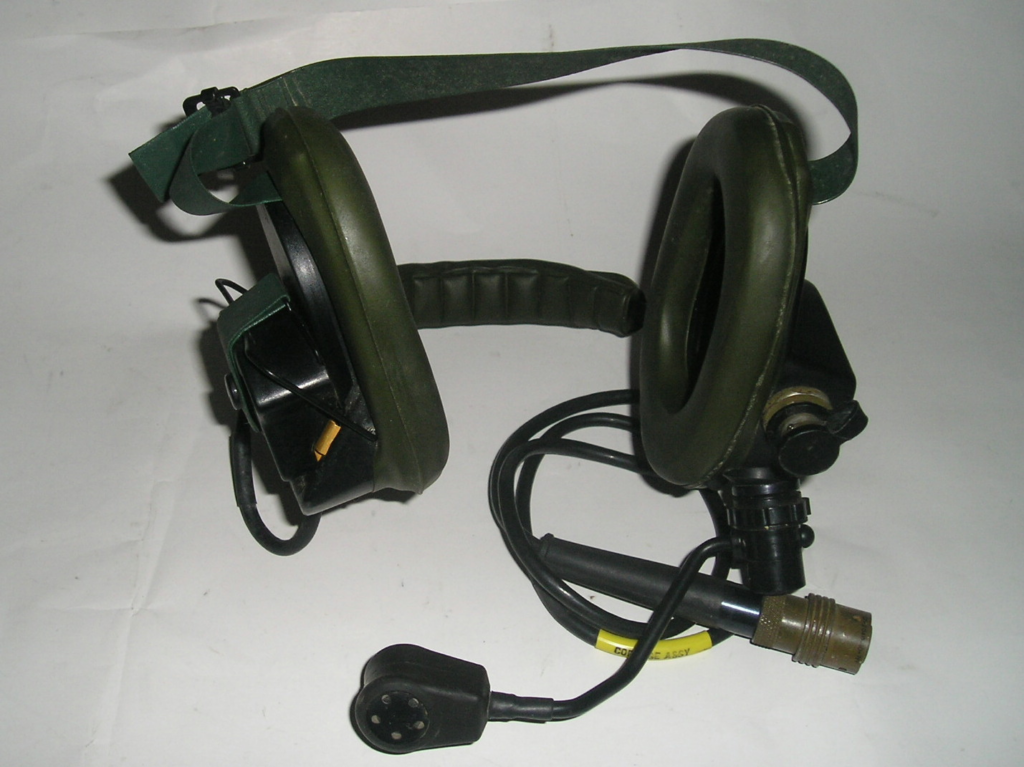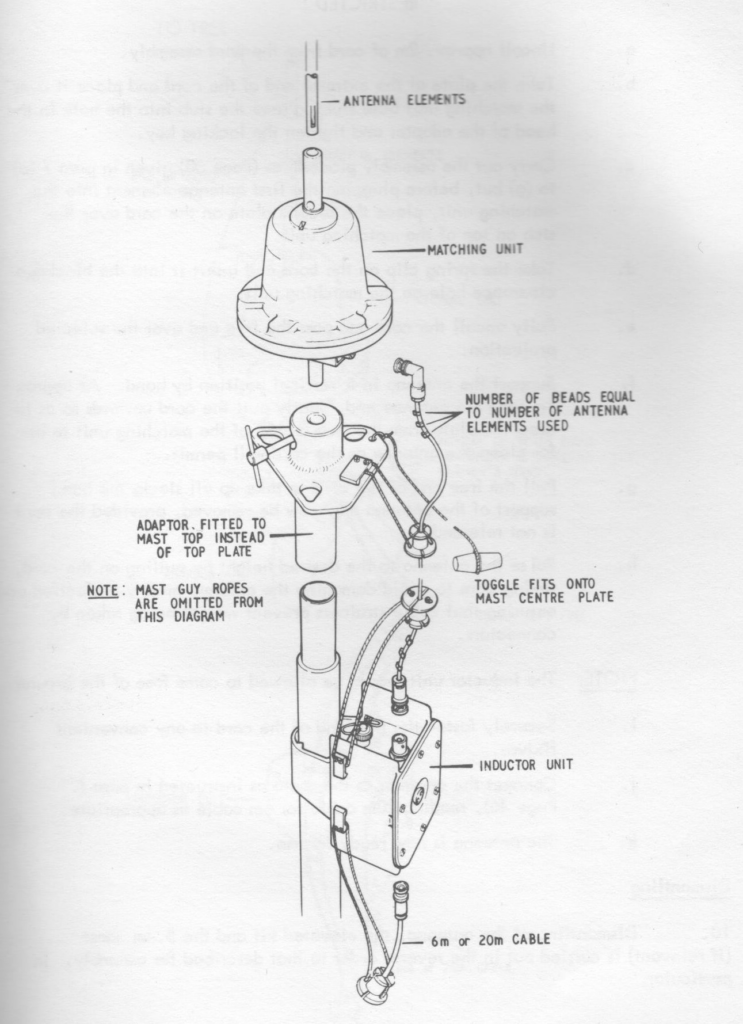Following on from Larkspur to Clansman part 2, we continue with a look at some of
the accessories used with manpack sets, and Rebroadcast operation.
Accessories common to most Clansman sets
The compatibility of audio accessories between the various Clansman radios is an important part of the system. The following items can be used with all of the radios already mentioned in the text: namely RT350, RT351/2, RT320, RT321, and RT353.
Clansman Handset General Purpose (NSN 5965-99-620-5669)
The lightweight handset made by Racal Acoustics is probably the most common and popular accessory. The handset uses a simple noise cancelling dynamic microphone that produces very good communications quality speech. This is reasonably well sealed against the ingress of dust and water with micro-switches in both the audio and PTT lines. Earpieces are the well-proven rocking armature type, being a smaller version of the ones used with Larkspur. These handsets were perhaps not quite as robust as they could have been, with the clothing clip often being torn off and the edges of the rear cover broken which compromises sealing. There were two types of cord, coiled and straight, many surplus handsets having faulty leads. Fortunately these have plug-in connections and are easily changed.
Handset Remote Control (NSN 5820-99-620-5670)
These are the same as the lightweight handset but with the addition of two press terminals to connect the two-wire DON10 cable. These handsets also incorporate a package that regulates the currents required for correct remote control of PTT and receive functions.
This handset cannot be used with the RT350, which does not have remote control.
The picture also shows Pouch Handset (NSN 5820-99-620-8031) often used to carry the
“Officers” handset, permitting operation and monitoring via the second socket.
Infantry & “B” Vehicle Headgear (NSN 5965-99-620-8320)
Again designed by Racal Acoustics for the Clansman range of manpack and “B” vehicle radio sets. This is generally the standard headgear for portable operation, lightweight vehicles and base station use. This headset is very comfortable with excellent receive audio quality. The boom microphone employs the same cartridge as that of the handset. The right hand (satellite) earshell is detachable, leaving its circumaural earpad in position to stabilize the assembly. Thus allowing ambient sounds to be freely heard if desired. All of the Clansman headgear assemblies have a snatch plug that will detach from the Pressel switch box or commanders box if pulled sharply. This allows soldiers to exit from vehicles in an emergency without having to first unscrew plugs or remove helmets and headsets.

Noise excluding headset (Sonovalve II)
Another RACAL acoustics product designed to provide hearing protection and communication where the user is required to wear standard steel helmets. Noise excluding earshells incorporate the Racal acoustic valve, which can be opened to permit the passage of airborne sounds but retain protection against explosive noises. Typical applications include soft-top military vehicles, command posts and gun sites etc. As noise excluding headsets go, these are relatively comfortable for extended periods of use.

Switch Electrical (Pressel Box) (NSN 9565-99-763-7915)
The Switch Electrical is necessary when headgear assemblies are used and provides a method of keying the transmitter. The seven-pin plug lead connects to the radio or harness box, with the headset snatch-plug connecting to the socket. The Pressel Box is fitted with a switch that allows the microphone audio to be made permanently live, providing constant intercom facilities. When Headsets are used with the Commanders Personal Unit (CPU) the pressel box is not necessary as CPUs have their own PTT switch. Pressel boxes have a 1.5 metre lead with later versions being supplied with a coiled six-way cord. The units are fitted with a clothing clip.

Audio Extension Lead (NSN 5820-99-117-6142)
Used mainly with the RT350, which does not have remote facilities so that the operator can locate up to ten metres away from the radio. The set can also be placed in an elevated position, such as a wall, building or tree.

GSA
The Ground-Spike Antenna (GSA) is normally used with the RT350 and RT351 or 352 allowing the operator to locate in a safer position up to six meters from the antenna. The GSA consists of a mounting base containing a loading coil and spike for insertion in the ground. The aerial covers between 30-76MHz depending upon the number of rods used. The GSA kits normally contain five 25 inch or in the later issue kits, ten 13 inch rods.
EKGSA
The Elevation Kit Ground Spike Antenna allows the GSA to be mounted at the top of the 5.4 metre Clansman mast, tree or other elevated structure. The Inductor RF (Coaxial) is inserted in the coaxial cable from the GSA base together with one of three different lengths of matching section, chosen according to frequency band being worked.
| The choice of band being used | No. of Short Rods (13”) | No. of Long Rods (26”) | |
| 30-53MHz | Coax 1 | 7-10 | 4 |
| 52-71MHz | Coax 2 | 5-7 | 3 |
| 70-76MHz | Coax 3 | 4-5 | 2 |
The shorter rods allow more accurate tuning, found by practical trials or by using an SWR meter. The main disadvantage of the EKGSA being that a change of frequency band requires it to be lowered for alterations to the number rods and matching cables.
Rebroadcast
Automatic rebroadcast was mentioned in Part 1 with details on the RT353. In fact all of the VHF sets transmit the standard NATO tone centred on 150Hz. This tone is necessary to allow interworking with the radios used by other NATO forces, such as the SEM25, and is required to open the tone controlled squelch.
When enabled on the receiving set, the tone triggers the rebroadcast facility. In civilian terms such tones are now known as CTCSS (Continuously Tone Coded Signalling System) but are sent at a much lower deviation than that used with Clansman. The level normally being about 10% (+/-300Hz) of system deviation. Clansman uses a level of around 25% of main deviation (1.6KHz). This relatively high level tone is filtered out in the receiver and is only faintly heard by the operator. For amateur purposes the tone is not required and may be found to annoy some of those using receivers that do not have good filtering of the audio pass band (300-3400Hz). The tone from Clansman radios can be reduced or turned off, the method depending upon the particular set, exact details will follow at a later date if enough readers express an interest.
Simple Re-broadcast using the RT351
Connecting together a pair of PRC351 or 352 sets provides one of the simplest and useful applications of rebroadcast. This is easy to set up and just requires the two radios to be linked together by a pair of wires to the remote terminals.
The sets can be a few meters apart or separated by a DON10 cable of up to 3km length. This allows either one or both sets to be located on high ground. There is also the advantage that the transmitter can be located remotely and away from the operator making the position less vulnerable to radio direction finding.
The next installment continues by looking at the harness system and power supplies for vehicle radios.
Barry G8DXU
Copyright 18.12.2013





